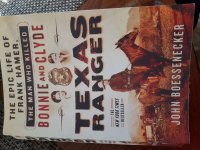Darkenfast
Member
I'm surprised nobody has cited the original primary source i.e., Ordnance Dept. manual No. 1866, page 13. The implied primary carry method is, magazine full and empty-chamber. The emergency carry is cock-and-locked with a full magazine.
Side-note, the manual also issues the "modern" use of trigger-discipline when using the firearm.
Description of the automatic pistol, caliber .45, model of 1911; with rules for management, memoranda of trajectory, and description of ammunition ... April 1, 1912 : United States. Ordanace dept : Free Download, Borrow, and Streaming : Internet Archive
Thank you posting that! Now we have the Army's view from 1914. Aside from the method-of-carry info posted above, I noticed a couple of interesting things on a quick read-through: First, the trigger pull was stated as being between 6-7 1/2 pounds. People who criticize trigger weight on some designs (such as issued 1911s and FN's Browning High Power), should remember that heavier trigger pulls were specified by the customer (and for good reasons). My 76C BHP breaks at approximately 6 crisp pounds and I am quite happy with it! Second, the ammunition velocity was stated to be just over 800 fps in the 1911, which tells us just what the Government expected (and what we should expect out of our FMJ ammunition). Third, look at the dispersion and accuracy tables in that manual. If they were using stock guns as examples for the manual, then those early 1911s were accurate, even when fired rapidly.
I am one of those who thinks that the day of the .45 ACP and the 1911 is long done as far as a military purchased and issued weapons system. I also think that the 1911 were hands-down the best handgun of the World War I era and the next few decades.


